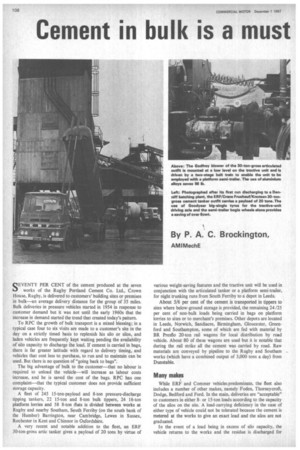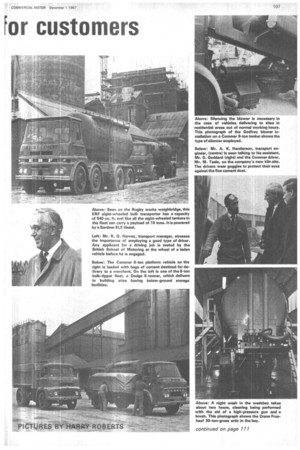Cement in bulk is a must
Page 108

Page 109

Page 113

If you've noticed an error in this article please click here to report it so we can fix it.
for customers
By P. A. C. Brockington,
AM1MechE
SEVENTY PER CENT of the cement produced at the seven works of the Rugby Portland Cement Co. Ltd., Crown House, Rugby, is delivered to customers' building sites or premises in bulk—an average delivery distance for the group of 35 miles. Bulk deliveries in pressure vehicles started in 1954 in response to customer demand but it was not until the early 1960s that the increase in demand started the trend that created today's pattern.
To RPC the growth of bulk transport is a mixed blessing; in a typical case four to six visits are made to a customer's site in the day on a strictly timed basis to replenish his silo or silos, and laden vehicles are frequently kept waiting pending the availability of silo capacity to discharge the load. If cement is carried in bags, there is far greater latitude with regard to delivery timing, and vehicles that cost less to purchase, to run and to maintain can be used. But there is no question of "going back to bags".
The big advantage of bulk to the customer—that no labour is required to unload the vehicle—will increase as labour costs increase, and he is saved the cost of the bags. RPC has one complaint—that the typical customer does not provide sufficient storage capacity.
A fleet of 245 15-ton-payload and 8-ton pressure-discharge tipping tankers, 22 15-ton and 8-ton bulk tippers, 24 16-ton platform lorries and 58 8-ton fiats is divided between works at Rugby and nearby Soutbam, South Ferriby (on the south bank of the Humber) Barrington, near Cambridge, Lewes in Sussex, Rochester in Kent and Chinnor in Oxfordshire.
A very recent and notable addition to the fleet, an ERF 30-ton-gross artic tanker gives a payload of 20 tons by virtue of various weight-saving features and the tractive unit will be used in conjunction with the articulated tanker or a platform semi-trailer, for night trunking runs from South Ferriby to a depot in Leeds.
About 5/6 per cent of the cement is transported in tippers to sites where below-ground storage is provided, the remaining 24/25 per cent of non-bulk loads being carried in bags on platform lorries to sites or to merchant's premises. Other depots are located in Leeds, Norwich, Sandiaere, Birmingham, Gloucester, Greenford and Southampton, some of which are fed with material by BR Presflo 20-ton rail wagons for local distribution by road vehicle. About 80 of these wagons are used but it is notable that during the rail strike all the cement was carried by road. Raw materials are conveyed by pipeline to the Rugby and Southam works (which have a combined output of 3,000 tons a day) from Dunstable.
Many makes
While ERF and Commer vehicles predominate, the fleet also includes a number of other makes, namely Foden, Thorneyeroft, Dodge, Bedford and Ford. In the main, deliveries are "acceptable" to customers in either 8or 15-ton loads according to the capacity of the silos on the site. A load-carrying deficiency in the case of either type of vehicle could not be tolerated because the cement is metered at the works to give an exact load and the silos are not graduated.
In the event of a load being in excess of silo capacity, the vehicle returns to the works and the residue is discharged for weighing to provide an accurate assessment of the amount of cement delivered.
All the tankers, tippers and platform vehicles are equipped with aluminium bodies in the interests of-lightness, the tanks being of Metalair, Carmichael and Knutsen manufacture. The pressure rating of the tanks is around 6/7 p.s.i.
The low weight of the Knutsen-bodied ERF/Crane Fruehauf articulated tanker is derived from the use of Goodyear big-single tyres for the tractive-unit driving axle and the bogie wheels (which saves over 6ewt) and of various fittings, in addition to a light-alloy (welded) tank. These fittings include for example, the belt pulleys of the Godfrey blowers (which afford a saving of .561b) pressurerelief valves, three-way cocks and Unicone pipe couplings.




























































































































































































